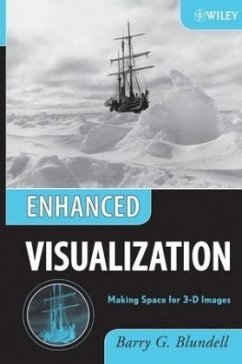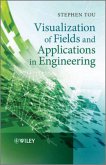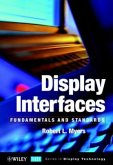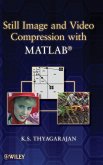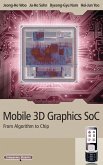- Gebundenes Buch
- Merkliste
- Auf die Merkliste
- Bewerten Bewerten
- Teilen
- Produkt teilen
- Produkterinnerung
- Produkterinnerung
A comprehensive guide to the technologies and techniques used to enable computer-processed images to occupy a 3-D space
This authoritative book focuses on the technologies and techniques that may be used to enable computer-processed images to occupy a three-dimensional (3-D) space. Images depicted in this way take on many of the attributes that we associate with the traditional sculptured image and naturally satisfy a range of pictorial, oculomotor, and binocular depth cues, thereby avoiding depth cue conflict and viewing discomfort. In addition, this opens up exciting opportunities that…mehr
Andere Kunden interessierten sich auch für
![Visualization of Fields and Applications in Engineering Visualization of Fields and Applications in Engineering]() Stephen TouVisualization of Fields and Applications in Engineering121,99 €
Stephen TouVisualization of Fields and Applications in Engineering121,99 €![Display Interfaces Display Interfaces]() Robert L. MyersDisplay Interfaces169,99 €
Robert L. MyersDisplay Interfaces169,99 €![Modern Machine Learning Techniques and Their Applications in Cartoon Animation Research Modern Machine Learning Techniques and Their Applications in Cartoon Animation Research]() Jun YuModern Machine Learning Techniques and Their Applications in Cartoon Animation Research98,99 €
Jun YuModern Machine Learning Techniques and Their Applications in Cartoon Animation Research98,99 €![Color Gamut Mapping Color Gamut Mapping]() Jan MorovicColor Gamut Mapping110,99 €
Jan MorovicColor Gamut Mapping110,99 €![Video Compression Video Compression]() K S ThyagarajanVideo Compression132,99 €
K S ThyagarajanVideo Compression132,99 €![Mobile 3D Graphics Soc Mobile 3D Graphics Soc]() Hoi-Jun YooMobile 3D Graphics Soc168,99 €
Hoi-Jun YooMobile 3D Graphics Soc168,99 €![Color Constancy Color Constancy]() Marc EbnerColor Constancy167,99 €
Marc EbnerColor Constancy167,99 €-
-
-
A comprehensive guide to the technologies and techniques used to enable computer-processed images to occupy a 3-D space
This authoritative book focuses on the technologies and techniques that may be used to enable computer-processed images to occupy a three-dimensional (3-D) space. Images depicted in this way take on many of the attributes that we associate with the traditional sculptured image and naturally satisfy a range of pictorial, oculomotor, and binocular depth cues, thereby avoiding depth cue conflict and viewing discomfort. In addition, this opens up exciting opportunities that exist for the development of new interaction tools and techniques.
Enhanced Visualization provides a refreshing and wide-ranging insight into approaches for radically advancing our communication with the digital world.
Content includes:
_ Discussion of a broad range of creative 3-D display system techniques
_ An extensive background review of volumetric systems
_ A chapter devoted to research undertaken in connection with varifocal systems
_ Identification of various types of image space
_ Consideration of interaction opportunities offered by different forms of image space
_ The impact of different display modalities upon graphics engine hardware and software
_ Suggestions for technologies and techniques that warrant significant research efforts
_ A comprehensive range of references
A transdisciplinary approach makes the content accessible to a wide-ranging audience. This book will be of great value to undergraduate and graduate students, to researchers involved in advancing interaction with the digital world, and also to those involved in investing in new forms of computer interaction technologies.
This authoritative book focuses on the technologies and techniques that may be used to enable computer-processed images to occupy a three-dimensional (3-D) space. Images depicted in this way take on many of the attributes that we associate with the traditional sculptured image and naturally satisfy a range of pictorial, oculomotor, and binocular depth cues, thereby avoiding depth cue conflict and viewing discomfort. In addition, this opens up exciting opportunities that exist for the development of new interaction tools and techniques.
Enhanced Visualization provides a refreshing and wide-ranging insight into approaches for radically advancing our communication with the digital world.
Content includes:
_ Discussion of a broad range of creative 3-D display system techniques
_ An extensive background review of volumetric systems
_ A chapter devoted to research undertaken in connection with varifocal systems
_ Identification of various types of image space
_ Consideration of interaction opportunities offered by different forms of image space
_ The impact of different display modalities upon graphics engine hardware and software
_ Suggestions for technologies and techniques that warrant significant research efforts
_ A comprehensive range of references
A transdisciplinary approach makes the content accessible to a wide-ranging audience. This book will be of great value to undergraduate and graduate students, to researchers involved in advancing interaction with the digital world, and also to those involved in investing in new forms of computer interaction technologies.
Produktdetails
- Produktdetails
- Verlag: Wiley & Sons
- 1. Auflage
- Seitenzahl: 448
- Erscheinungstermin: 26. Februar 2007
- Englisch
- Abmessung: 235mm x 162mm x 28mm
- Gewicht: 750g
- ISBN-13: 9780471786290
- ISBN-10: 0471786292
- Artikelnr.: 22105144
- Herstellerkennzeichnung
- Libri GmbH
- Europaallee 1
- 36244 Bad Hersfeld
- gpsr@libri.de
- Verlag: Wiley & Sons
- 1. Auflage
- Seitenzahl: 448
- Erscheinungstermin: 26. Februar 2007
- Englisch
- Abmessung: 235mm x 162mm x 28mm
- Gewicht: 750g
- ISBN-13: 9780471786290
- ISBN-10: 0471786292
- Artikelnr.: 22105144
- Herstellerkennzeichnung
- Libri GmbH
- Europaallee 1
- 36244 Bad Hersfeld
- gpsr@libri.de
Barry G. Blundell, PhD, is a physicist and engineer who has worked in the area of 3-D display and interaction systems since the late 1980s. His research interests in the development of new forms of creative digital media are intended to advance natural and synergistic interaction with the digital world. The author is involved in promoting new technologies and techniques for distance education-particularly for use in third world countries-and also in highlighting ethical issues arising as a consequence of the deployment, networking, and accessibility of computer systems.
Preface.
Acknowledgements.
Chapter One. Setting the Scene.
1.1 Introduction.
1.2 Historical Background.
1.2.1 Interaction.
1.2.2 The Display, Data Stream and Interaction Tool Interface.
1.2.3 The Conventional Display.
1.2.4 Raster and Vector Graphics.
1.3 Working within a 2-D Space.
1.4 Concerning Interaction.
1.5 Image and Interaction Spaces.
1.6 Introducing Volumetric and Varifocal Techniques.
1.6.1 The Volumetric Technique.
1.6.2 The Essence of the Volumetric paradigm.
1.6.3 The Varifocal Approach.
1.7 Discussion.
1.8 Investigations.
Chapter Two. Aspects of the Visual System.
2.1 Introduction.
2.2 Some Characteristics of the Eye.
2.3 Depth Cues.
2.3.1 Pictorial Cues.
2.3.2 Oculomotor Cues.
2.3.3 Motion Parallax.
2.3.4 Stereopsis (Binocular Parallax).
2.4 Considerations on Image Refresh.
2.5 Discussion.
2.6 Investigations.
Chapter 3. Creative 3-D Display Techniques.
3.1Introduction.
3.2 Display Subsystems.
3.3 Stereoscopic Techniques.
3.3.1 A 'Fog Penetrating' Televisor.
3.4Extending the Stereoscopic Approach.
3.5 The Physical 3-D Image and its Electronic Rendition.
3.6 Multi-view Displays.
3.7 On Painting and Sculpture.
3.7.1 Information Content.
3.7.2 Working within a 3-D Space.
3.7.3 Display Capability.
3.8 Discussion.
3.9 Investigations.
Chapter 4. The Swept-Volume Approach.
4.1 Introduction.
4.2 Exemplar Swept-Volume Techniques.
4.3 Swept-Volume Subsystems.
4.3.1 Image Space Creation.
4.3.2 Voxel Generation.
4.3.3 Voxel Activation.
4.4 Parallelism in Voxel Activation.
4.4.1 Restrictions in Voxel Activation.
4.4.2 Designing for Predictability.
4.5 Hardware Based Characterisation.
4.6 The Acceptance of Motion.
4.7 Dead Zones.
4.7.1 The Voxel Placement Dead Zone.
4.7.2 Distortional (Elongation) Dead Zone.
4.7.3 The Visual Dead Zone.
4.7.4 Other Forms of Dead Zone.
4.8 Discussion.
4.9 Investigations.
Chapter 5. The Static-Volume Approach.
5.1 Introduction.
5.2 An Elementary Static-Volume Implementation.
5.3 Image Space Composition.
5.4 The Classification of Static-Volume Systems.
5.5 Voxel Visibility.
5.6 Beam Intersection and the Stepwise Excitation of Fluorescence.
5.6.1 The Stepwise Excitation of Fluorescence in Gaseous Media.
5.6.2 The Stepwise Excitation of Fluorescence in Non-Gaseous Media.
5.7 The Photochromic Approach.
5.8 Dead Zones.
5.9 Discussion.
5.10 Investigations.
Chapter 6. Swept-Volume Systems: Limited Viewing Freedom.
6.1 Introduction.
6.2 Image Slices and Image Planes.
6.3 John Logie Baird Makes Space for the Third Dimension.
6.3.1 Perhaps the First Swept-Volume Displays.
6.3.2 Baird Advances Volumetric Image Depiction.
6.4 Parallel Image Planes Using Translational Motion.
6.4.1 A Reciprocating CRT.
6.4.2 Image Slices Focused onto a Moving Screen.
6.4.3 Image Slices Reflected by a Mirror: A Sinusoidal Velocity Profile.
6.4.4 The Peritron.
6.4.5 Image Slices Reflected using a Linearly Moving Mirror.
6.4.6 Image Slices Created using an Active Surface of Emission.
6.5 Parallel Image Planes Using Rotational Motion.
6.5.1 Image Planes Formed by Rotors Equipped with an Active Surface of
Emission.
6.5.2 Image Planes Formed by the Rotation of a Series of Mirrors.
6.5.3 Image Planes Formed by the Rotation of a Fiber Optic Bundle.
6.5.4 The Archimedes Spiral Approach.
6.6 Discussion.
6.7 Investigations.
Chapter 7. Low Parallelism Swept-Volume Systems.
7.1 Introduction.
7.2 The Planar Screen and Fixed Beam Source(s).
7.2.1 The Planar Screen and Stationary Electron Gun(s).
7.2.2 The Video Frequency with Exhaustive Scanning.
7.3 The Planar Screen and Constant Beam Source Geometry.
7.3.1 The Planar Screen and Co-Rotating Electron Guns.
7.3.2 The Planar Screen and Non-Evasive Projection Techniques.
7.4 A Helical Screen and Passive SOE.
7.4.1 A Helix within a CRT.
7.4.2 HL3D Systems.
7.4.3 Projection onto a Helical screen.
7.5 Alternative Configurations.
7.5.1 A Tilted Planar Screen.
7.5.2 An Alternative Screen Shape.
7.5.3 Augmenting the Planar Screen.
7.5.4 A Sliced Fiber Bundle.
7.5.5 Two Degrees of Freedom.
7.6 An Early Volumetric Radar Display.
7.7 Discussion.
7.8 Investigations.
Chapter 8. Highly Parallel Swept-Volume Systems.
8.1 Introduction.
8.2 The Planar Screen and Active Surface of Emission.
8.3 The Planar Screen and Passive Surface of Emission.
8.3.1 A Plurality of Scanned Beam sources.
8.3.2 The Perspecta Display.
8.3.3 Images cast onto Rotating Mirrors.
8.4 The Helical Screen and Active Surface of Emission.
8.5 The Helical screen and Passive Surface of Emission.
8.6 The Relative Rotations of a Screen and an Array of Light Sources.
8.7 The Spinning Lens Approach.
8.8 Discussion.
8.9 Investigations.
Chapter 9. Static-Volume Systems: Example Implementations.
9.1 Introduction.
9.2 The Use of an Active Matrix of Voxel Generation Elements.
9.2.1 From Bulbs to Gas Discharge.
9.2.2 A Gas Discharge Display.
9.2.3 An Optical Fiber Technique.
9.2.4 A Stack of LCD Panels Illuminated with Polarized Light.
9.3 Voxel Activation Using Directed Beam Sources.
9.3.1 Electron Beams and a Series of Screen Meshes.
9.3.2 An Image Space Comprising Dust Particles.
9.4 The DepthCube?
9.5 The Beam Intersection Approach.
9.5.1 The Stepwise Excitation of Mercury Vapour.
9.5.2 Erbium Doped Calcium Fluoride.
9.5.3 Rare Earth Doped ZBLAN.
9.5.4 The use of Phosphor Particles Dispersed in a 3-D Medium.
9.5.5 Beam Intersection in a Phosphor Cloud.
9.5.6 The Intersection of Particle Beams in a Gas.
9.6 Stacking Image Slices.
9.6.1 The Use of Beam Splitters: Basic Configuration.
9.6.2 The Use of Beam Splitters: With Additional Optical Components.
9.7 Discussion.
9.8 Investigations.
Chapter 10. Varifocal Mirror Techniques.
10.1 Introduction.
10.2 The Geometry of the Curved Mirror.
10.3 Spherical Aberration.
10.4 Technical Considerations.
10.4.1 Image Update and Acoustic Noise.
10.4.2 Mirror Motion.
10.5 Varifocal Display System Development.
10.5.1 The Work of Alan Traub.
10.5.2 The Work of Eric Rawson.
10.5.3 The Work of Lawrence Sher.
10.5.4 The Application of the Varifocal Mirror to Medical Imaging.
10.5.5 The Work of King and Berry.
10.5 Discussion.
10.6 Investigations.
Chapter 11. The Graphics Pipeline and Interaction Issues.
11.1 Introduction.
11.2 Graphics Engine: Input and Output.
11.3 The Graphics Engine: Sequential Voxel Activation.
11.4 The Graphics Engine: Parallel Voxel Activation.
11.4.1 A Parallel Architecture.
11.5 Parallel Data Transfer.
11.6 Concerning Interaction.
11.6.1 The 'Free Space' Image.
11.6.2 ?Free? Image Space: Directly Generated and Projection Techniques.
11.7 Discussion.
11.8 Investigations.
Chapter 12. General Discussion: Suggestions Du Jour.
12.1 Introduction.
12.2 The Varifocal Technique.
12.3 Do Electron Beams Have a Future Role in Voxel Activation?.
12.4 Gas Discharge Devices.
12.5 The Stepwise Excitation of Fluorescence.
12.6 Other Approaches.
12.7 Discussion.
Appendix: A General Summary of Some Swept-Volume Display Characteristics.
References.
Index.
Acknowledgements.
Chapter One. Setting the Scene.
1.1 Introduction.
1.2 Historical Background.
1.2.1 Interaction.
1.2.2 The Display, Data Stream and Interaction Tool Interface.
1.2.3 The Conventional Display.
1.2.4 Raster and Vector Graphics.
1.3 Working within a 2-D Space.
1.4 Concerning Interaction.
1.5 Image and Interaction Spaces.
1.6 Introducing Volumetric and Varifocal Techniques.
1.6.1 The Volumetric Technique.
1.6.2 The Essence of the Volumetric paradigm.
1.6.3 The Varifocal Approach.
1.7 Discussion.
1.8 Investigations.
Chapter Two. Aspects of the Visual System.
2.1 Introduction.
2.2 Some Characteristics of the Eye.
2.3 Depth Cues.
2.3.1 Pictorial Cues.
2.3.2 Oculomotor Cues.
2.3.3 Motion Parallax.
2.3.4 Stereopsis (Binocular Parallax).
2.4 Considerations on Image Refresh.
2.5 Discussion.
2.6 Investigations.
Chapter 3. Creative 3-D Display Techniques.
3.1Introduction.
3.2 Display Subsystems.
3.3 Stereoscopic Techniques.
3.3.1 A 'Fog Penetrating' Televisor.
3.4Extending the Stereoscopic Approach.
3.5 The Physical 3-D Image and its Electronic Rendition.
3.6 Multi-view Displays.
3.7 On Painting and Sculpture.
3.7.1 Information Content.
3.7.2 Working within a 3-D Space.
3.7.3 Display Capability.
3.8 Discussion.
3.9 Investigations.
Chapter 4. The Swept-Volume Approach.
4.1 Introduction.
4.2 Exemplar Swept-Volume Techniques.
4.3 Swept-Volume Subsystems.
4.3.1 Image Space Creation.
4.3.2 Voxel Generation.
4.3.3 Voxel Activation.
4.4 Parallelism in Voxel Activation.
4.4.1 Restrictions in Voxel Activation.
4.4.2 Designing for Predictability.
4.5 Hardware Based Characterisation.
4.6 The Acceptance of Motion.
4.7 Dead Zones.
4.7.1 The Voxel Placement Dead Zone.
4.7.2 Distortional (Elongation) Dead Zone.
4.7.3 The Visual Dead Zone.
4.7.4 Other Forms of Dead Zone.
4.8 Discussion.
4.9 Investigations.
Chapter 5. The Static-Volume Approach.
5.1 Introduction.
5.2 An Elementary Static-Volume Implementation.
5.3 Image Space Composition.
5.4 The Classification of Static-Volume Systems.
5.5 Voxel Visibility.
5.6 Beam Intersection and the Stepwise Excitation of Fluorescence.
5.6.1 The Stepwise Excitation of Fluorescence in Gaseous Media.
5.6.2 The Stepwise Excitation of Fluorescence in Non-Gaseous Media.
5.7 The Photochromic Approach.
5.8 Dead Zones.
5.9 Discussion.
5.10 Investigations.
Chapter 6. Swept-Volume Systems: Limited Viewing Freedom.
6.1 Introduction.
6.2 Image Slices and Image Planes.
6.3 John Logie Baird Makes Space for the Third Dimension.
6.3.1 Perhaps the First Swept-Volume Displays.
6.3.2 Baird Advances Volumetric Image Depiction.
6.4 Parallel Image Planes Using Translational Motion.
6.4.1 A Reciprocating CRT.
6.4.2 Image Slices Focused onto a Moving Screen.
6.4.3 Image Slices Reflected by a Mirror: A Sinusoidal Velocity Profile.
6.4.4 The Peritron.
6.4.5 Image Slices Reflected using a Linearly Moving Mirror.
6.4.6 Image Slices Created using an Active Surface of Emission.
6.5 Parallel Image Planes Using Rotational Motion.
6.5.1 Image Planes Formed by Rotors Equipped with an Active Surface of
Emission.
6.5.2 Image Planes Formed by the Rotation of a Series of Mirrors.
6.5.3 Image Planes Formed by the Rotation of a Fiber Optic Bundle.
6.5.4 The Archimedes Spiral Approach.
6.6 Discussion.
6.7 Investigations.
Chapter 7. Low Parallelism Swept-Volume Systems.
7.1 Introduction.
7.2 The Planar Screen and Fixed Beam Source(s).
7.2.1 The Planar Screen and Stationary Electron Gun(s).
7.2.2 The Video Frequency with Exhaustive Scanning.
7.3 The Planar Screen and Constant Beam Source Geometry.
7.3.1 The Planar Screen and Co-Rotating Electron Guns.
7.3.2 The Planar Screen and Non-Evasive Projection Techniques.
7.4 A Helical Screen and Passive SOE.
7.4.1 A Helix within a CRT.
7.4.2 HL3D Systems.
7.4.3 Projection onto a Helical screen.
7.5 Alternative Configurations.
7.5.1 A Tilted Planar Screen.
7.5.2 An Alternative Screen Shape.
7.5.3 Augmenting the Planar Screen.
7.5.4 A Sliced Fiber Bundle.
7.5.5 Two Degrees of Freedom.
7.6 An Early Volumetric Radar Display.
7.7 Discussion.
7.8 Investigations.
Chapter 8. Highly Parallel Swept-Volume Systems.
8.1 Introduction.
8.2 The Planar Screen and Active Surface of Emission.
8.3 The Planar Screen and Passive Surface of Emission.
8.3.1 A Plurality of Scanned Beam sources.
8.3.2 The Perspecta Display.
8.3.3 Images cast onto Rotating Mirrors.
8.4 The Helical Screen and Active Surface of Emission.
8.5 The Helical screen and Passive Surface of Emission.
8.6 The Relative Rotations of a Screen and an Array of Light Sources.
8.7 The Spinning Lens Approach.
8.8 Discussion.
8.9 Investigations.
Chapter 9. Static-Volume Systems: Example Implementations.
9.1 Introduction.
9.2 The Use of an Active Matrix of Voxel Generation Elements.
9.2.1 From Bulbs to Gas Discharge.
9.2.2 A Gas Discharge Display.
9.2.3 An Optical Fiber Technique.
9.2.4 A Stack of LCD Panels Illuminated with Polarized Light.
9.3 Voxel Activation Using Directed Beam Sources.
9.3.1 Electron Beams and a Series of Screen Meshes.
9.3.2 An Image Space Comprising Dust Particles.
9.4 The DepthCube?
9.5 The Beam Intersection Approach.
9.5.1 The Stepwise Excitation of Mercury Vapour.
9.5.2 Erbium Doped Calcium Fluoride.
9.5.3 Rare Earth Doped ZBLAN.
9.5.4 The use of Phosphor Particles Dispersed in a 3-D Medium.
9.5.5 Beam Intersection in a Phosphor Cloud.
9.5.6 The Intersection of Particle Beams in a Gas.
9.6 Stacking Image Slices.
9.6.1 The Use of Beam Splitters: Basic Configuration.
9.6.2 The Use of Beam Splitters: With Additional Optical Components.
9.7 Discussion.
9.8 Investigations.
Chapter 10. Varifocal Mirror Techniques.
10.1 Introduction.
10.2 The Geometry of the Curved Mirror.
10.3 Spherical Aberration.
10.4 Technical Considerations.
10.4.1 Image Update and Acoustic Noise.
10.4.2 Mirror Motion.
10.5 Varifocal Display System Development.
10.5.1 The Work of Alan Traub.
10.5.2 The Work of Eric Rawson.
10.5.3 The Work of Lawrence Sher.
10.5.4 The Application of the Varifocal Mirror to Medical Imaging.
10.5.5 The Work of King and Berry.
10.5 Discussion.
10.6 Investigations.
Chapter 11. The Graphics Pipeline and Interaction Issues.
11.1 Introduction.
11.2 Graphics Engine: Input and Output.
11.3 The Graphics Engine: Sequential Voxel Activation.
11.4 The Graphics Engine: Parallel Voxel Activation.
11.4.1 A Parallel Architecture.
11.5 Parallel Data Transfer.
11.6 Concerning Interaction.
11.6.1 The 'Free Space' Image.
11.6.2 ?Free? Image Space: Directly Generated and Projection Techniques.
11.7 Discussion.
11.8 Investigations.
Chapter 12. General Discussion: Suggestions Du Jour.
12.1 Introduction.
12.2 The Varifocal Technique.
12.3 Do Electron Beams Have a Future Role in Voxel Activation?.
12.4 Gas Discharge Devices.
12.5 The Stepwise Excitation of Fluorescence.
12.6 Other Approaches.
12.7 Discussion.
Appendix: A General Summary of Some Swept-Volume Display Characteristics.
References.
Index.
Preface.
Acknowledgements.
Chapter One. Setting the Scene.
1.1 Introduction.
1.2 Historical Background.
1.2.1 Interaction.
1.2.2 The Display, Data Stream and Interaction Tool Interface.
1.2.3 The Conventional Display.
1.2.4 Raster and Vector Graphics.
1.3 Working within a 2-D Space.
1.4 Concerning Interaction.
1.5 Image and Interaction Spaces.
1.6 Introducing Volumetric and Varifocal Techniques.
1.6.1 The Volumetric Technique.
1.6.2 The Essence of the Volumetric paradigm.
1.6.3 The Varifocal Approach.
1.7 Discussion.
1.8 Investigations.
Chapter Two. Aspects of the Visual System.
2.1 Introduction.
2.2 Some Characteristics of the Eye.
2.3 Depth Cues.
2.3.1 Pictorial Cues.
2.3.2 Oculomotor Cues.
2.3.3 Motion Parallax.
2.3.4 Stereopsis (Binocular Parallax).
2.4 Considerations on Image Refresh.
2.5 Discussion.
2.6 Investigations.
Chapter 3. Creative 3-D Display Techniques.
3.1Introduction.
3.2 Display Subsystems.
3.3 Stereoscopic Techniques.
3.3.1 A 'Fog Penetrating' Televisor.
3.4Extending the Stereoscopic Approach.
3.5 The Physical 3-D Image and its Electronic Rendition.
3.6 Multi-view Displays.
3.7 On Painting and Sculpture.
3.7.1 Information Content.
3.7.2 Working within a 3-D Space.
3.7.3 Display Capability.
3.8 Discussion.
3.9 Investigations.
Chapter 4. The Swept-Volume Approach.
4.1 Introduction.
4.2 Exemplar Swept-Volume Techniques.
4.3 Swept-Volume Subsystems.
4.3.1 Image Space Creation.
4.3.2 Voxel Generation.
4.3.3 Voxel Activation.
4.4 Parallelism in Voxel Activation.
4.4.1 Restrictions in Voxel Activation.
4.4.2 Designing for Predictability.
4.5 Hardware Based Characterisation.
4.6 The Acceptance of Motion.
4.7 Dead Zones.
4.7.1 The Voxel Placement Dead Zone.
4.7.2 Distortional (Elongation) Dead Zone.
4.7.3 The Visual Dead Zone.
4.7.4 Other Forms of Dead Zone.
4.8 Discussion.
4.9 Investigations.
Chapter 5. The Static-Volume Approach.
5.1 Introduction.
5.2 An Elementary Static-Volume Implementation.
5.3 Image Space Composition.
5.4 The Classification of Static-Volume Systems.
5.5 Voxel Visibility.
5.6 Beam Intersection and the Stepwise Excitation of Fluorescence.
5.6.1 The Stepwise Excitation of Fluorescence in Gaseous Media.
5.6.2 The Stepwise Excitation of Fluorescence in Non-Gaseous Media.
5.7 The Photochromic Approach.
5.8 Dead Zones.
5.9 Discussion.
5.10 Investigations.
Chapter 6. Swept-Volume Systems: Limited Viewing Freedom.
6.1 Introduction.
6.2 Image Slices and Image Planes.
6.3 John Logie Baird Makes Space for the Third Dimension.
6.3.1 Perhaps the First Swept-Volume Displays.
6.3.2 Baird Advances Volumetric Image Depiction.
6.4 Parallel Image Planes Using Translational Motion.
6.4.1 A Reciprocating CRT.
6.4.2 Image Slices Focused onto a Moving Screen.
6.4.3 Image Slices Reflected by a Mirror: A Sinusoidal Velocity Profile.
6.4.4 The Peritron.
6.4.5 Image Slices Reflected using a Linearly Moving Mirror.
6.4.6 Image Slices Created using an Active Surface of Emission.
6.5 Parallel Image Planes Using Rotational Motion.
6.5.1 Image Planes Formed by Rotors Equipped with an Active Surface of
Emission.
6.5.2 Image Planes Formed by the Rotation of a Series of Mirrors.
6.5.3 Image Planes Formed by the Rotation of a Fiber Optic Bundle.
6.5.4 The Archimedes Spiral Approach.
6.6 Discussion.
6.7 Investigations.
Chapter 7. Low Parallelism Swept-Volume Systems.
7.1 Introduction.
7.2 The Planar Screen and Fixed Beam Source(s).
7.2.1 The Planar Screen and Stationary Electron Gun(s).
7.2.2 The Video Frequency with Exhaustive Scanning.
7.3 The Planar Screen and Constant Beam Source Geometry.
7.3.1 The Planar Screen and Co-Rotating Electron Guns.
7.3.2 The Planar Screen and Non-Evasive Projection Techniques.
7.4 A Helical Screen and Passive SOE.
7.4.1 A Helix within a CRT.
7.4.2 HL3D Systems.
7.4.3 Projection onto a Helical screen.
7.5 Alternative Configurations.
7.5.1 A Tilted Planar Screen.
7.5.2 An Alternative Screen Shape.
7.5.3 Augmenting the Planar Screen.
7.5.4 A Sliced Fiber Bundle.
7.5.5 Two Degrees of Freedom.
7.6 An Early Volumetric Radar Display.
7.7 Discussion.
7.8 Investigations.
Chapter 8. Highly Parallel Swept-Volume Systems.
8.1 Introduction.
8.2 The Planar Screen and Active Surface of Emission.
8.3 The Planar Screen and Passive Surface of Emission.
8.3.1 A Plurality of Scanned Beam sources.
8.3.2 The Perspecta Display.
8.3.3 Images cast onto Rotating Mirrors.
8.4 The Helical Screen and Active Surface of Emission.
8.5 The Helical screen and Passive Surface of Emission.
8.6 The Relative Rotations of a Screen and an Array of Light Sources.
8.7 The Spinning Lens Approach.
8.8 Discussion.
8.9 Investigations.
Chapter 9. Static-Volume Systems: Example Implementations.
9.1 Introduction.
9.2 The Use of an Active Matrix of Voxel Generation Elements.
9.2.1 From Bulbs to Gas Discharge.
9.2.2 A Gas Discharge Display.
9.2.3 An Optical Fiber Technique.
9.2.4 A Stack of LCD Panels Illuminated with Polarized Light.
9.3 Voxel Activation Using Directed Beam Sources.
9.3.1 Electron Beams and a Series of Screen Meshes.
9.3.2 An Image Space Comprising Dust Particles.
9.4 The DepthCube?
9.5 The Beam Intersection Approach.
9.5.1 The Stepwise Excitation of Mercury Vapour.
9.5.2 Erbium Doped Calcium Fluoride.
9.5.3 Rare Earth Doped ZBLAN.
9.5.4 The use of Phosphor Particles Dispersed in a 3-D Medium.
9.5.5 Beam Intersection in a Phosphor Cloud.
9.5.6 The Intersection of Particle Beams in a Gas.
9.6 Stacking Image Slices.
9.6.1 The Use of Beam Splitters: Basic Configuration.
9.6.2 The Use of Beam Splitters: With Additional Optical Components.
9.7 Discussion.
9.8 Investigations.
Chapter 10. Varifocal Mirror Techniques.
10.1 Introduction.
10.2 The Geometry of the Curved Mirror.
10.3 Spherical Aberration.
10.4 Technical Considerations.
10.4.1 Image Update and Acoustic Noise.
10.4.2 Mirror Motion.
10.5 Varifocal Display System Development.
10.5.1 The Work of Alan Traub.
10.5.2 The Work of Eric Rawson.
10.5.3 The Work of Lawrence Sher.
10.5.4 The Application of the Varifocal Mirror to Medical Imaging.
10.5.5 The Work of King and Berry.
10.5 Discussion.
10.6 Investigations.
Chapter 11. The Graphics Pipeline and Interaction Issues.
11.1 Introduction.
11.2 Graphics Engine: Input and Output.
11.3 The Graphics Engine: Sequential Voxel Activation.
11.4 The Graphics Engine: Parallel Voxel Activation.
11.4.1 A Parallel Architecture.
11.5 Parallel Data Transfer.
11.6 Concerning Interaction.
11.6.1 The 'Free Space' Image.
11.6.2 ?Free? Image Space: Directly Generated and Projection Techniques.
11.7 Discussion.
11.8 Investigations.
Chapter 12. General Discussion: Suggestions Du Jour.
12.1 Introduction.
12.2 The Varifocal Technique.
12.3 Do Electron Beams Have a Future Role in Voxel Activation?.
12.4 Gas Discharge Devices.
12.5 The Stepwise Excitation of Fluorescence.
12.6 Other Approaches.
12.7 Discussion.
Appendix: A General Summary of Some Swept-Volume Display Characteristics.
References.
Index.
Acknowledgements.
Chapter One. Setting the Scene.
1.1 Introduction.
1.2 Historical Background.
1.2.1 Interaction.
1.2.2 The Display, Data Stream and Interaction Tool Interface.
1.2.3 The Conventional Display.
1.2.4 Raster and Vector Graphics.
1.3 Working within a 2-D Space.
1.4 Concerning Interaction.
1.5 Image and Interaction Spaces.
1.6 Introducing Volumetric and Varifocal Techniques.
1.6.1 The Volumetric Technique.
1.6.2 The Essence of the Volumetric paradigm.
1.6.3 The Varifocal Approach.
1.7 Discussion.
1.8 Investigations.
Chapter Two. Aspects of the Visual System.
2.1 Introduction.
2.2 Some Characteristics of the Eye.
2.3 Depth Cues.
2.3.1 Pictorial Cues.
2.3.2 Oculomotor Cues.
2.3.3 Motion Parallax.
2.3.4 Stereopsis (Binocular Parallax).
2.4 Considerations on Image Refresh.
2.5 Discussion.
2.6 Investigations.
Chapter 3. Creative 3-D Display Techniques.
3.1Introduction.
3.2 Display Subsystems.
3.3 Stereoscopic Techniques.
3.3.1 A 'Fog Penetrating' Televisor.
3.4Extending the Stereoscopic Approach.
3.5 The Physical 3-D Image and its Electronic Rendition.
3.6 Multi-view Displays.
3.7 On Painting and Sculpture.
3.7.1 Information Content.
3.7.2 Working within a 3-D Space.
3.7.3 Display Capability.
3.8 Discussion.
3.9 Investigations.
Chapter 4. The Swept-Volume Approach.
4.1 Introduction.
4.2 Exemplar Swept-Volume Techniques.
4.3 Swept-Volume Subsystems.
4.3.1 Image Space Creation.
4.3.2 Voxel Generation.
4.3.3 Voxel Activation.
4.4 Parallelism in Voxel Activation.
4.4.1 Restrictions in Voxel Activation.
4.4.2 Designing for Predictability.
4.5 Hardware Based Characterisation.
4.6 The Acceptance of Motion.
4.7 Dead Zones.
4.7.1 The Voxel Placement Dead Zone.
4.7.2 Distortional (Elongation) Dead Zone.
4.7.3 The Visual Dead Zone.
4.7.4 Other Forms of Dead Zone.
4.8 Discussion.
4.9 Investigations.
Chapter 5. The Static-Volume Approach.
5.1 Introduction.
5.2 An Elementary Static-Volume Implementation.
5.3 Image Space Composition.
5.4 The Classification of Static-Volume Systems.
5.5 Voxel Visibility.
5.6 Beam Intersection and the Stepwise Excitation of Fluorescence.
5.6.1 The Stepwise Excitation of Fluorescence in Gaseous Media.
5.6.2 The Stepwise Excitation of Fluorescence in Non-Gaseous Media.
5.7 The Photochromic Approach.
5.8 Dead Zones.
5.9 Discussion.
5.10 Investigations.
Chapter 6. Swept-Volume Systems: Limited Viewing Freedom.
6.1 Introduction.
6.2 Image Slices and Image Planes.
6.3 John Logie Baird Makes Space for the Third Dimension.
6.3.1 Perhaps the First Swept-Volume Displays.
6.3.2 Baird Advances Volumetric Image Depiction.
6.4 Parallel Image Planes Using Translational Motion.
6.4.1 A Reciprocating CRT.
6.4.2 Image Slices Focused onto a Moving Screen.
6.4.3 Image Slices Reflected by a Mirror: A Sinusoidal Velocity Profile.
6.4.4 The Peritron.
6.4.5 Image Slices Reflected using a Linearly Moving Mirror.
6.4.6 Image Slices Created using an Active Surface of Emission.
6.5 Parallel Image Planes Using Rotational Motion.
6.5.1 Image Planes Formed by Rotors Equipped with an Active Surface of
Emission.
6.5.2 Image Planes Formed by the Rotation of a Series of Mirrors.
6.5.3 Image Planes Formed by the Rotation of a Fiber Optic Bundle.
6.5.4 The Archimedes Spiral Approach.
6.6 Discussion.
6.7 Investigations.
Chapter 7. Low Parallelism Swept-Volume Systems.
7.1 Introduction.
7.2 The Planar Screen and Fixed Beam Source(s).
7.2.1 The Planar Screen and Stationary Electron Gun(s).
7.2.2 The Video Frequency with Exhaustive Scanning.
7.3 The Planar Screen and Constant Beam Source Geometry.
7.3.1 The Planar Screen and Co-Rotating Electron Guns.
7.3.2 The Planar Screen and Non-Evasive Projection Techniques.
7.4 A Helical Screen and Passive SOE.
7.4.1 A Helix within a CRT.
7.4.2 HL3D Systems.
7.4.3 Projection onto a Helical screen.
7.5 Alternative Configurations.
7.5.1 A Tilted Planar Screen.
7.5.2 An Alternative Screen Shape.
7.5.3 Augmenting the Planar Screen.
7.5.4 A Sliced Fiber Bundle.
7.5.5 Two Degrees of Freedom.
7.6 An Early Volumetric Radar Display.
7.7 Discussion.
7.8 Investigations.
Chapter 8. Highly Parallel Swept-Volume Systems.
8.1 Introduction.
8.2 The Planar Screen and Active Surface of Emission.
8.3 The Planar Screen and Passive Surface of Emission.
8.3.1 A Plurality of Scanned Beam sources.
8.3.2 The Perspecta Display.
8.3.3 Images cast onto Rotating Mirrors.
8.4 The Helical Screen and Active Surface of Emission.
8.5 The Helical screen and Passive Surface of Emission.
8.6 The Relative Rotations of a Screen and an Array of Light Sources.
8.7 The Spinning Lens Approach.
8.8 Discussion.
8.9 Investigations.
Chapter 9. Static-Volume Systems: Example Implementations.
9.1 Introduction.
9.2 The Use of an Active Matrix of Voxel Generation Elements.
9.2.1 From Bulbs to Gas Discharge.
9.2.2 A Gas Discharge Display.
9.2.3 An Optical Fiber Technique.
9.2.4 A Stack of LCD Panels Illuminated with Polarized Light.
9.3 Voxel Activation Using Directed Beam Sources.
9.3.1 Electron Beams and a Series of Screen Meshes.
9.3.2 An Image Space Comprising Dust Particles.
9.4 The DepthCube?
9.5 The Beam Intersection Approach.
9.5.1 The Stepwise Excitation of Mercury Vapour.
9.5.2 Erbium Doped Calcium Fluoride.
9.5.3 Rare Earth Doped ZBLAN.
9.5.4 The use of Phosphor Particles Dispersed in a 3-D Medium.
9.5.5 Beam Intersection in a Phosphor Cloud.
9.5.6 The Intersection of Particle Beams in a Gas.
9.6 Stacking Image Slices.
9.6.1 The Use of Beam Splitters: Basic Configuration.
9.6.2 The Use of Beam Splitters: With Additional Optical Components.
9.7 Discussion.
9.8 Investigations.
Chapter 10. Varifocal Mirror Techniques.
10.1 Introduction.
10.2 The Geometry of the Curved Mirror.
10.3 Spherical Aberration.
10.4 Technical Considerations.
10.4.1 Image Update and Acoustic Noise.
10.4.2 Mirror Motion.
10.5 Varifocal Display System Development.
10.5.1 The Work of Alan Traub.
10.5.2 The Work of Eric Rawson.
10.5.3 The Work of Lawrence Sher.
10.5.4 The Application of the Varifocal Mirror to Medical Imaging.
10.5.5 The Work of King and Berry.
10.5 Discussion.
10.6 Investigations.
Chapter 11. The Graphics Pipeline and Interaction Issues.
11.1 Introduction.
11.2 Graphics Engine: Input and Output.
11.3 The Graphics Engine: Sequential Voxel Activation.
11.4 The Graphics Engine: Parallel Voxel Activation.
11.4.1 A Parallel Architecture.
11.5 Parallel Data Transfer.
11.6 Concerning Interaction.
11.6.1 The 'Free Space' Image.
11.6.2 ?Free? Image Space: Directly Generated and Projection Techniques.
11.7 Discussion.
11.8 Investigations.
Chapter 12. General Discussion: Suggestions Du Jour.
12.1 Introduction.
12.2 The Varifocal Technique.
12.3 Do Electron Beams Have a Future Role in Voxel Activation?.
12.4 Gas Discharge Devices.
12.5 The Stepwise Excitation of Fluorescence.
12.6 Other Approaches.
12.7 Discussion.
Appendix: A General Summary of Some Swept-Volume Display Characteristics.
References.
Index.
"...the book will give you both the scientific and factual basis to express the outcome of the visualisation process in the most effective way." ( British Computer Society Book Reviews )
"...a wonderful introduction to multidimensional display systems for people new to the field, and can also serve as a great reference for practitioners." ( Computing Reviews.com , September 13, 2007)
"...a wonderful introduction to multidimensional display systems for people new to the field, and can also serve as a great reference for practitioners." ( Computing Reviews.com , September 13, 2007)

